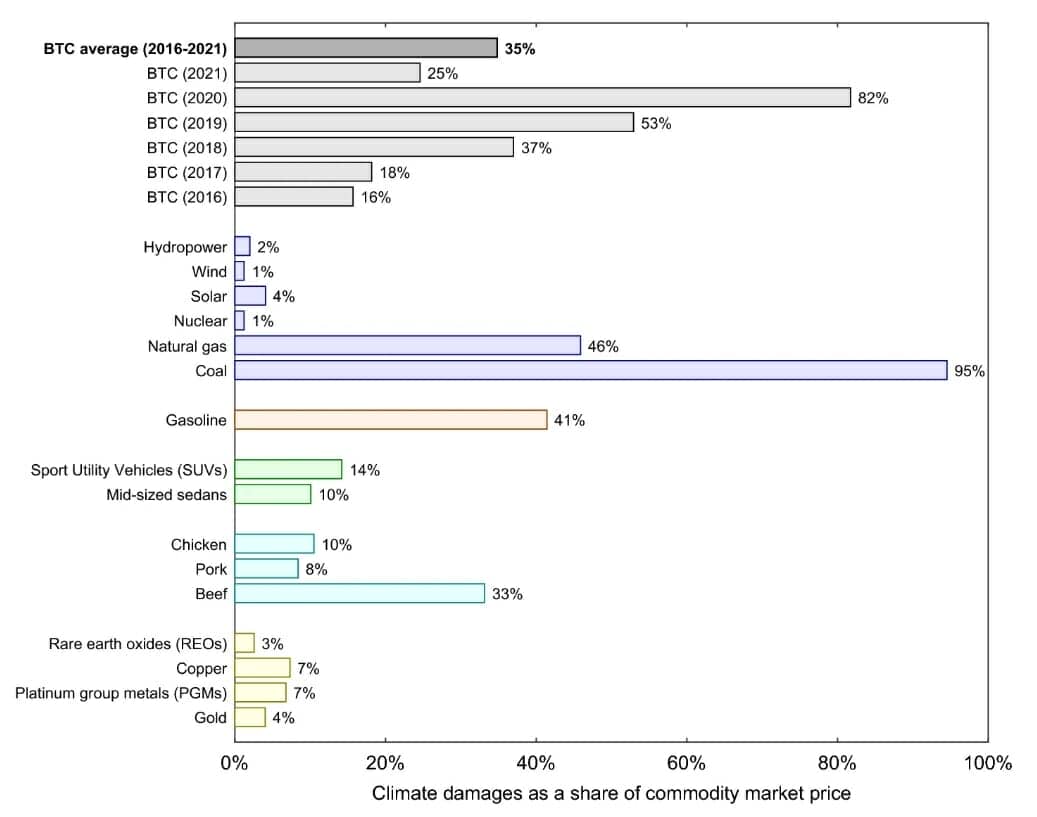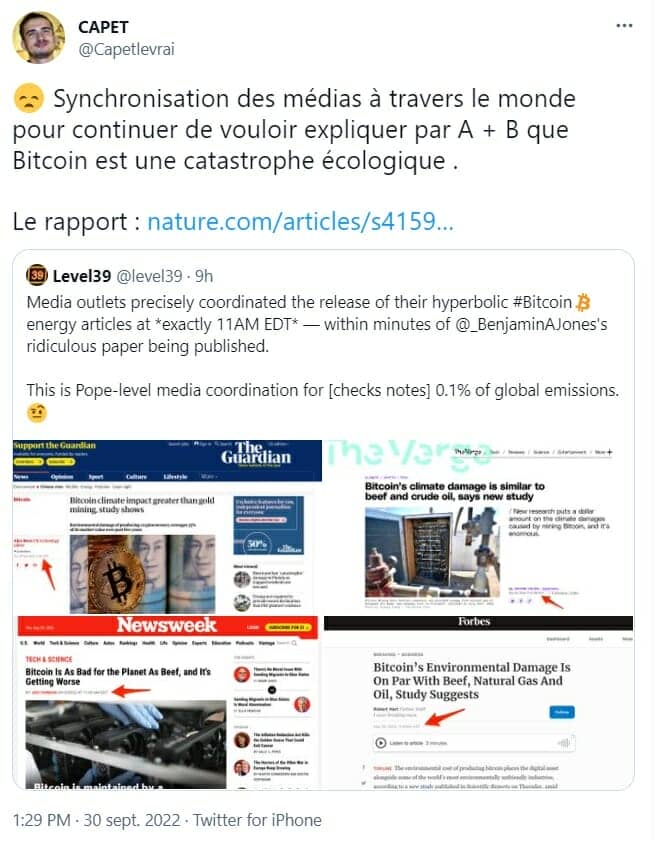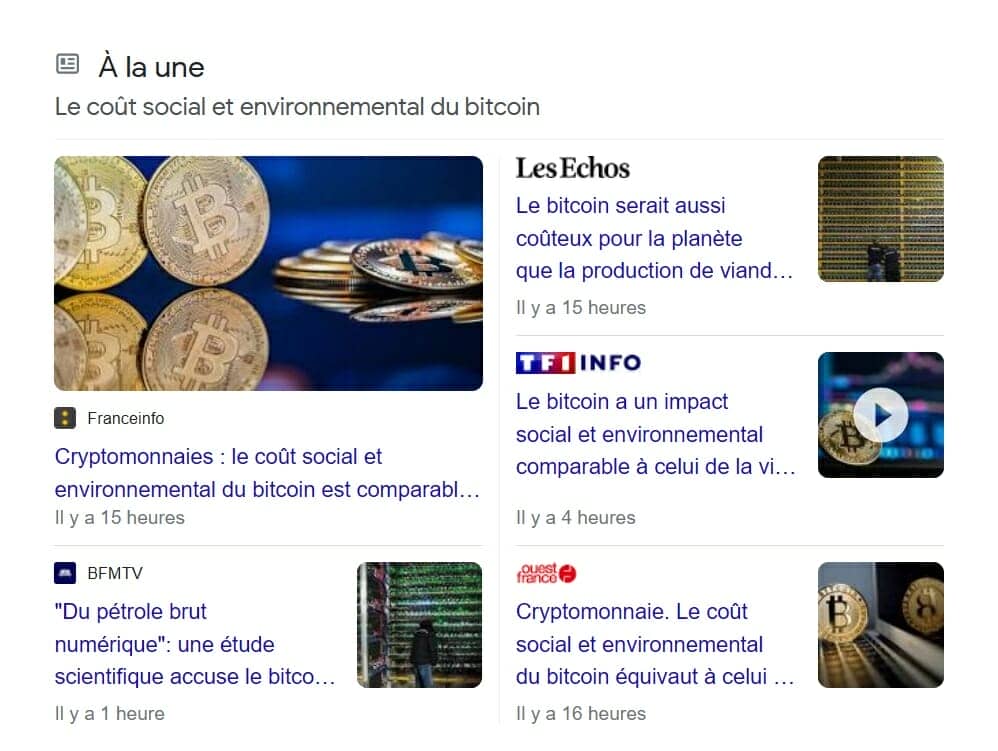Bitcoin, scapegoat for an ecological cataclysm? The media of the Western world highlight, and in a perfectly synchronized way, a study published in the famous Scientific Reports. The latter connects the bitcoin price (BTC) and its energy cost.
Bitcoin, energy, price and climate
The last study of the Cambridge Center for Alternative Finance (CCAF) tried to quantify the global emissions of carbon dioxide (and other greenhouse gases) due to minors of Bitcoin. According to the researchers, they would represent approximately 0.1% of the total.
This should make it possible to put the harmfulness of the network into perspective. Indeed, for Bitcoin detractors, its energy costand therefore by extension its environmental impactis one of the main arguments justifying its prohibition.
However, the empire strikes back! A new study published in the journal Nature in return castigates the king of cryptocurrencies on the same ground.
Let’s try to grasp the substance of the 10-page report of Scientific Reportsproduced by 3 economists:
- Benjamin A. Jones, associate professor in the Department of Economics at the University of New Mexico;
- Andrew Goodkind, assistant professor at the same university;
- Robert P. Berrens, also professor of economics at UNM.
The fact that our three teachers specialize in economyand not in physicalin energy or in thermodynamics should redouble the attention of the reader who has the courage to read their paper.
Bitcoin price and energy
The published data relate the evolution of the bitcoin price (from 2016 to 2021) with the amount of electricity necessary to maintain and secure the network. The latter is expressed in MWh/BTC. It is estimated based on the hash rate of the network andmaterial efficiency of mining.
What a surprise ! As the adoption of bitcoin increases, its price increases and so does its energy cost.
So far, nothing new under the sun. These data are then used to assess theenvironmental impact of this electricity consumption. They are combined with the figure put forward by the University of Cambridge, according to which 39% of the electricity used by the Bitcoin network would come from so-called ” renewable“.
By deduction, 61% of the energy needed for mining by proof of work would therefore be “dirty”, because it is responsible for emissions of carbon dioxide (now solely responsible for environmental problems).
Climate damage and dollars
Since themonetary inflation bitcoins decreases over time, and that its difficulty (and therefore its energy cost) increasethe amount of CO2 issued by BTC increases. Again, that makes perfect sense. CO emissions2 represent the climate damage caused by Bitcoin and are expressed in dollars.

The last graph represents the climate damage of Bitcoin as a percentage of its price. This concept is interesting. How to quantify “climate damage” in dollars?

The report is based on the social cost of carbon (CCS). This is an estimate of marginal economic costs corresponding to the issue ofa ton of CO2. It was produced by the Brookings Papers on Economic Activity (BPEA). The BPEA mathematically justifies this value by a whole series of complex equations with arbitrary variables.
The calculation and valuation methods of the different variables have been widely criticized in the scientific world. Indeed, these calculations are generally the work of private entities with murky conflicts of interest. The data varies over time and the lobbies using them for political or economic purposes.
Be that as it may, and assuming that it is possible to economically quantify the impact of carbon emissions, let’s come back to the paper of our three professors.
Sustainability criteria
These define three sustainability criteria for the bitcoin network.
First, the “climate damage trend estimated by BTC mined should not increase, as the industry matures”. A criterion that Bitcoin fails since the energy cost of mining a BTC increases over time.
Second, “the price of a mined BTC should always exceed the cost of its estimated climate damage”. Here again, the BTC fails since over the period studied, this was only the case when the BTC was in full bull run.
Third, the weather damage cost per 1 dollar of BTC is compared to those of different amenities ranging from oil to beef. Bitcoin fails again, as its climate damage cost is 2% higher than that of the meat (although it remains much lower than that of the coalfrom natural gas or oil). You will notice the scientific relevance of this criterion.

Model criticism
It is obviously the first two criteria that will make anti-Bitcoin shudder with horror. Indeed, our teachers deduce that the climate damage inflicted by the ugly decentralized network will continue to increase !
To do this, they have fun in particular varying the percentage renewable energies used by the network, up to 63%. Here again, we do not know where this comes from. arbitrary ceiling. It is however obvious that it is one day quite possible to undermine in a way 100% renewablein particular thanks to thehydro-electricity and at the geothermal energy. These discussions would therefore stop dead.
The discussion also focuses on the widely disputed figure of the CSC (admitted in the report). The $100/t of CO2 are thus reduced to 50 and then 150. Unsurprisingly, we come to the same conclusion from our professors emeritus.
However, they seem to forget that the bitcoin price has a huge impact on their calculations. In the event of a bull run and a BTC at $100,000 with a hashrate slightly higher, their conclusions fall apart.
We will obviously pass over the usual simplification of the global ecological problem to a single symptom, temperature, due to a single factor, CO2. Similarly, total deadlock on the positive externalities of the Bitcoin network for society, requiring, like any tool,energy to work.
There is a more surprising point with this study. It’s about the eagerness with which the media mainstream of the western world have synchronized to resume, to the nearest hour, this report.
This was notably noted by a Twitter user under the exasperated gaze of our friend Capet:

This surge of dispatches, taking up the report without hindsight or critical analysis, comes precisely right after the famous Cambridge study.
On the side of our dear french mediasame story:

Let’s just see a simple coincidence. We could be seen, we sect bitcoin, as annoying plotters. It’s probably unrelated to the issues that may well revive savers’ interest in Bitcoin, such as theinflation which exceeds two figures in Europe, the setbacks of the Bank of England, the desire to close the PEL or even the voyeurism of Bercy on the bank accounts of the French….
Note also the omnipotence of Google Newswhose algorithm highlights this type of hastily written articles. SEO obliges, the freelancer anxious to see his articles go up to the top of the page resumes, without technical knowledge of the subjects evoked, the dispatches proposed by the press agencies dominating the flow of information.
Bitcoin always dies but never surrenders
We live a strange time where, unlike Bitcoin, the consensus science is no longer really based on proof of work. The ecological argument is a powerful weapon, playing on guilt, and has become almost unstoppable. In a deleterious economic context, the banking world has taken the measure of the bitcoin hazard. A bank run A progressive move towards cryptocurrencies would indeed be much more damaging than a rush towards ATMs, observed for example in Greece and Lebanon and advocated by Éric Cantonna. The parade of clichés conveyed by the general press rests on the shoulders of brave miners. The industry continues to develop and strive for moreenergy efficiencyas evidenced by recent initiatives Congolese Where Salvadoran. There is no doubt that our central bankers, wishing to keep their backyard, the coinage privilegewill find new attack vectors.
Who wants to drown his dog accuses him of rabies, and service to others is not an inheritance.
